CRMs and CDPs are often confused for each other; it could be the similarity of their names or how each focuses on customer data. But these two technologies are actually quite distinct, both in the breadth of their capabilities and the purpose they serve.
But for brevity’s sake, the main difference to remember is: Customer Relationship Management Systems (CRMs) help manage customer relationships, particularly in a sales or customer support context. Customer Data Platforms (CDPs) manage the collection, cleanliness, unification, and activation of customer data that’s been generated from every touchpoint – or in other words, the entire customer lifecycle.
Of course, there’s a lot more nuance to it than that. Let’s get into it.
First things first: what’s a CDP?
A customer data platform (CDP) is software that collects, cleans, and consolidates customer data at scale. A CDP helps integrate a company’s tech stack with pre-built or custom integrations, and orchestrate the flow of data between them. It establishes a single source of truth within a company along with helping to create unified customer profiles and specific audience segments based on user traits or behaviors.
On top of that, a CDP can help companies comply with data privacy regulations like the GDPR and CCPA, with features like data masking and role-based access controls.
In general, a CDP’s capabilities will span data collection, cleaning, compliance, unification, and activation.
OK, then: what is a CRM?
A Customer Relationship Management (CRM) tool is used to help manage and improve customer interactions (usually in Sales or Customer Support). For example, in a CRM you would likely find data like:
The date, time, and method of communication a customer used to reach out to a company or Sales representative.
Notes from a Sales rep or Customer Service agent on an interaction (e.g., if an introductory call or demo, what questions the prospect asked).
A log of that prospect/customer’s previous interactions with the brand for added context.
CRM vs. CDP: what’s the difference?
If both CRMs and CDPs help collect and manage customer data, you may be wondering: what’s the difference between the two?
In short, CRMs organize and manage customer-facing interactions with your team while CDPs collect and consolidate data from across your entire tech stack to understand behavior and traits more broadly.
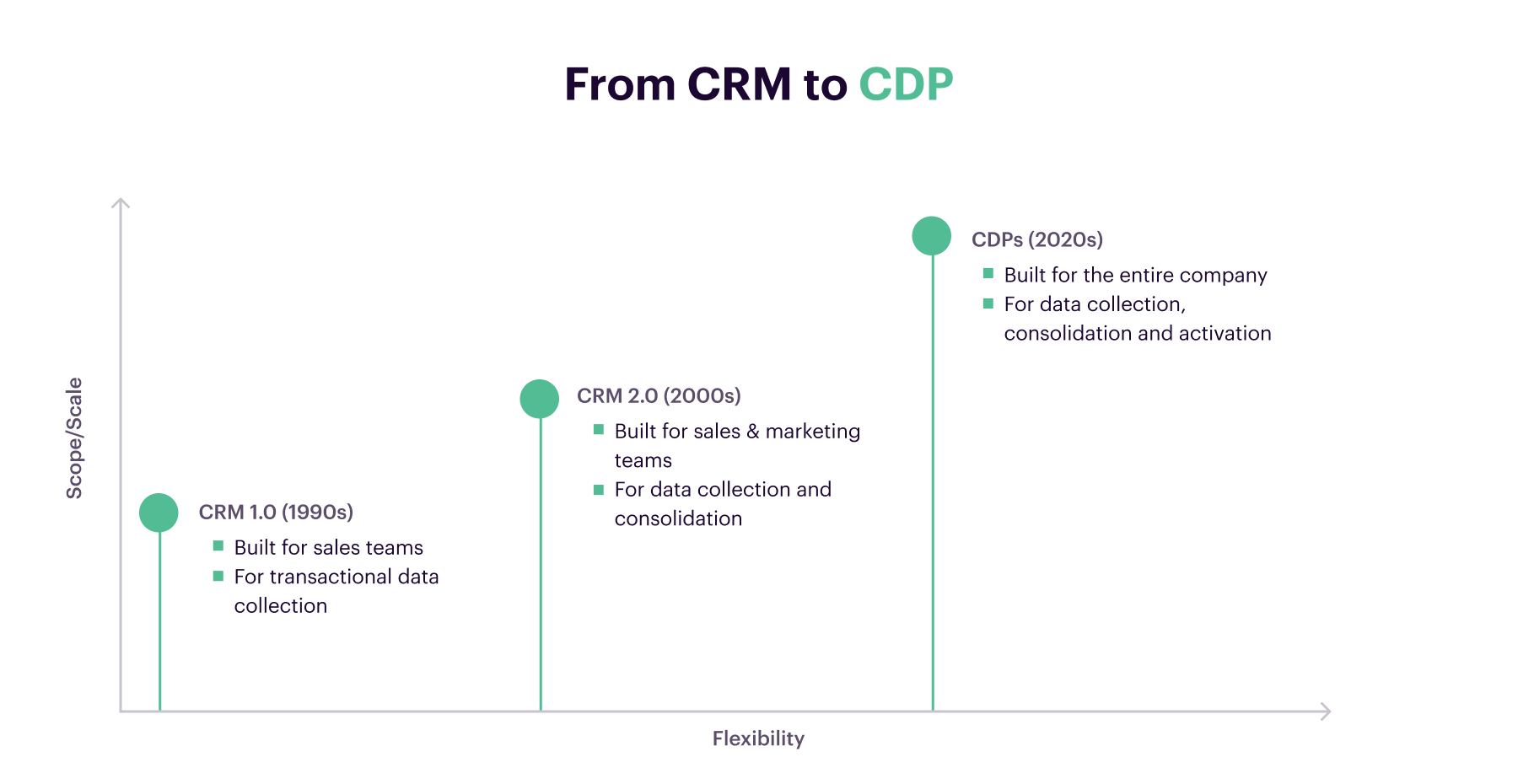
The goal of a CDP is to make high-level business decisions, launch more precise marketing campaigns, elevate customer engagement, and manage data quality at scale. CDPs do this by gathering data from every touchpoint – from ad clicks, to website traffic, points of transaction, in-product user behavior, offline interactions, and more. CDPs then consolidate this data to create a single source of truth and identity-resolved customer profiles.
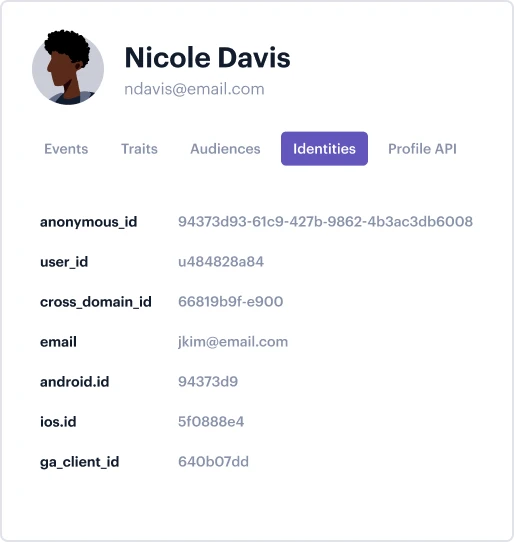
(The other technology CDPs are commonly compared to are DMPs. Read our breakdown on how DMPs and CDPs differ here.)
Who CDPs and CRMs are for
While CRMs are mainly designed for customer-facing roles, CDPs benefit every team across an organization (whether they’re in a technical or non-technical role).
Data democratization is a key characteristic of a CDP – it makes data and self-service analytics available to the people who need it (e.g., marketing can create highly personalized audience segments based on real-time data or even predictive analytics, without relying on a data analyst).
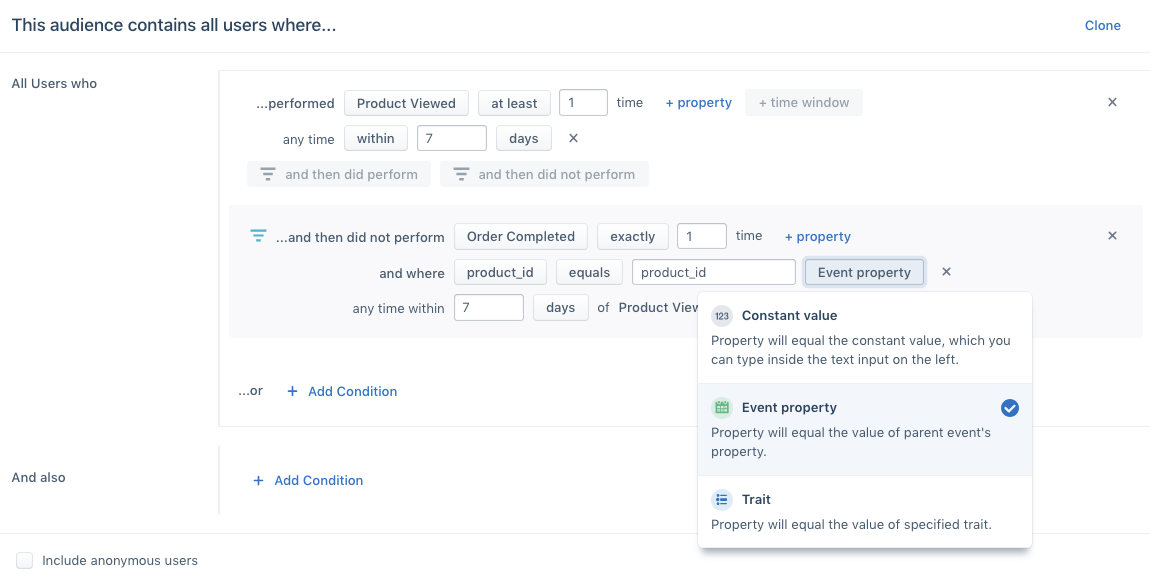
Creating an audience in Twilio Engage
In fact, CDPs can streamline several technical processes to reduce manual workloads – like building integrations. With Twilio Segment, businesses can choose from hundreds of pre-built connectors to integrate new tools in a matter of minutes (or create custom integration with just a few lines of code).
Then there’s maintaining data quality. Twilio Segment can automatically enforce data validation rules and even transform bad data as it flows from its source to destination.
How CRMs and CDPs gather and manage data
The data CRMs collect is often manually gathered, highly specific in its purpose, and can be hard to automate—like sales notes from your latest demo (and since each salesperson has their own way of taking notes, this can be difficult to standardize). CRM data is usually meant to be used in a CRM only, meaning the data you put in the CRM is controlled by the CRM. To get that data out, you’ll have to jump through some hoops.
On the other hand, CDPs are the solution for a fragmented tech stack. CDPs help teams gather customer data from mobile devices, laptops, your website or app, server-side sources (e.g., Python, Node, or Ruby), and then standardize and unify this data so it’s ready for activation. Teams can choose from a comprehensive catalog of integrations, while leveraging libraries, SDKs, and tracking specs to make implementation fast and seamless.
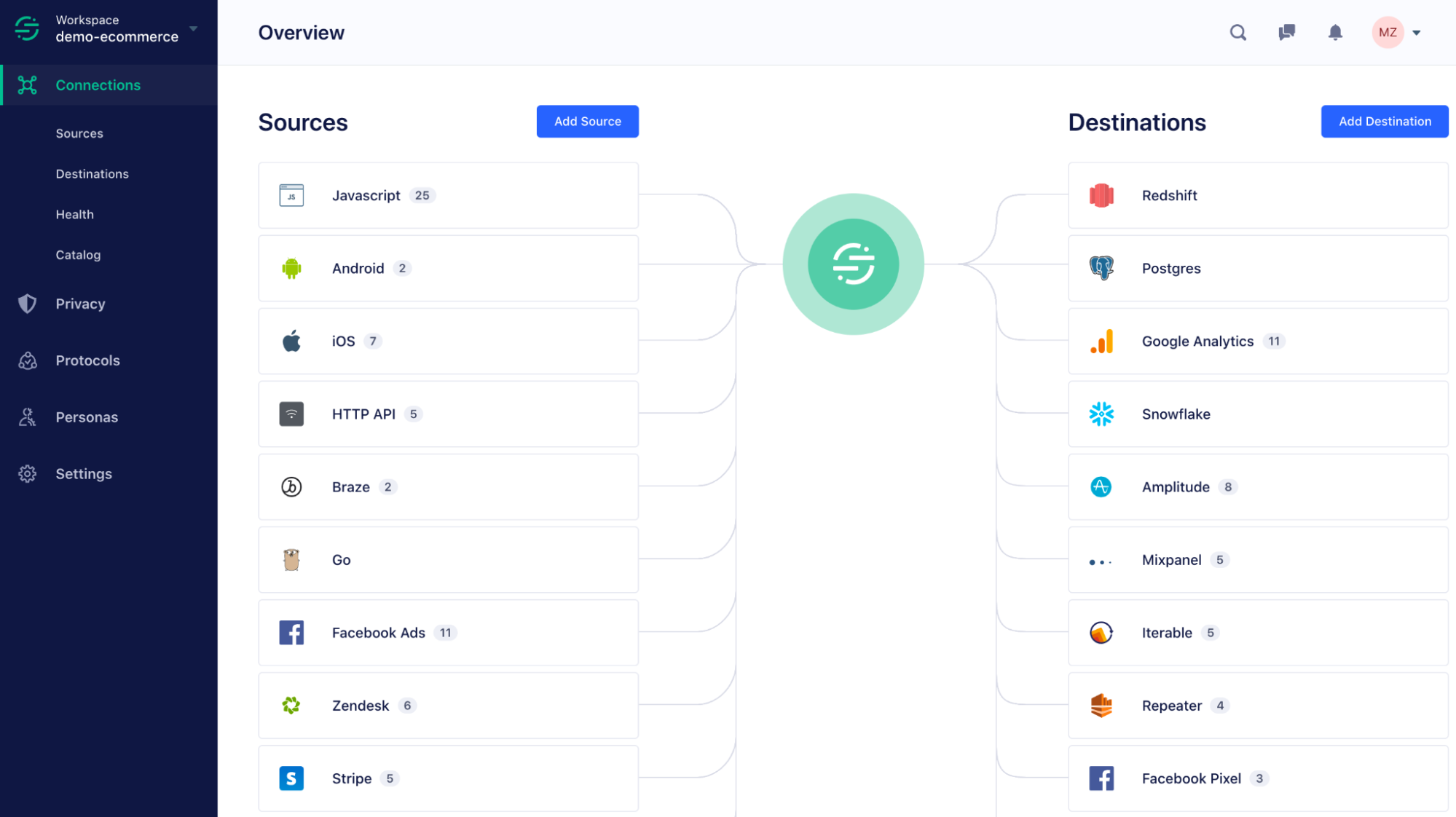
Segment’s Developer Toolkit also provides the freedom and flexibility to extend Segment’s CDP as needed. One feature of the Developer Toolkit is Destination Actions, to control how data is mapped to specific Destinations and to trigger a custom actions (e.g., adding a user to a campaign).
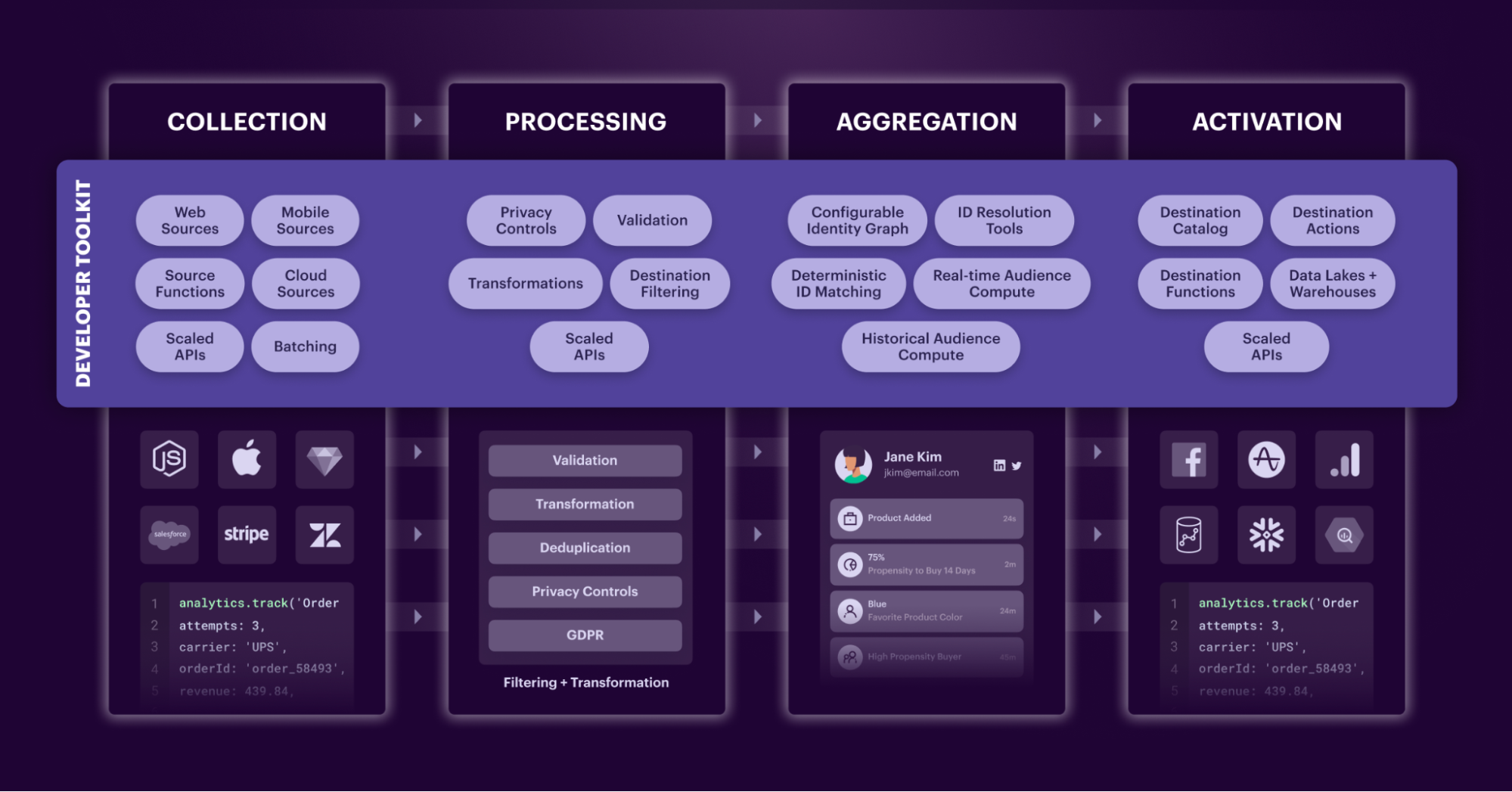
CRM vs. CDP: Which one is right for you?
For most companies, it’s not an either/or decision between CDPs and CRMs. Rather, these two technologies can work in tandem.
CDPs provide the infrastructure to scale data management and activation. They break down data silos that often pop up as organizations add more tools and platforms to their tech stack. (Here’s a look at last year’s Stackies, where people submit visual representations of their Marketing Stack, as a fun reference for how many tools a typical organization uses.)
CDPs not only promote interoperability, but they also automate data governance to protect data integrity (e.g., enforcing standardized naming conventions, flagging and fixing bad or duplicate data).
CRMs are great when it comes to managing customer relationships and sales cycles, but businesses tend to find that a CRM alone is not enough to understand how people interact with your entire business.
Customer Data Platform RFP Template
Evaluating a CDP? We've put together this customizable RFP template to help. Use it to get clarity on technical requirements, use cases, cost of ownership, and more.
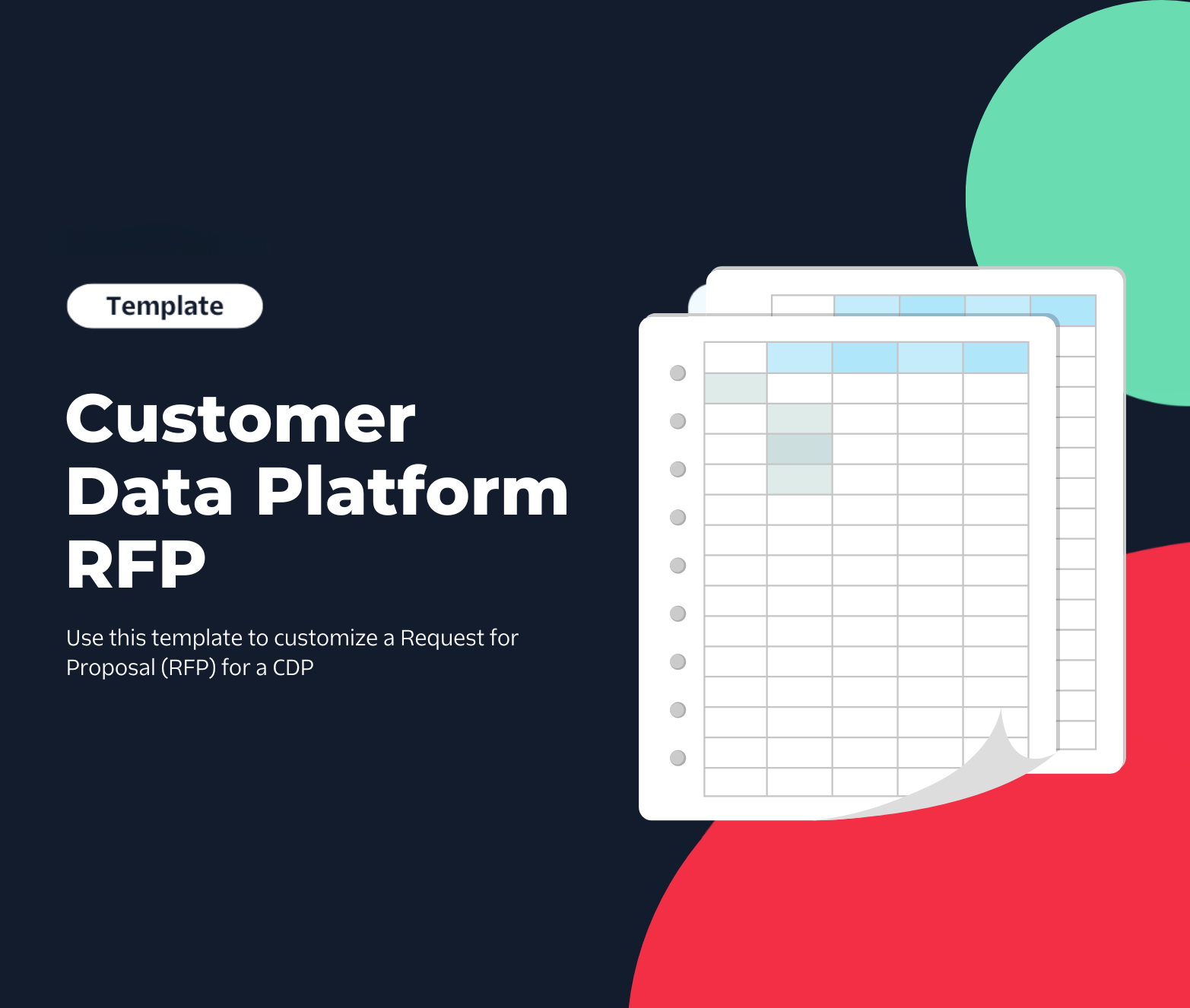
You’re all set!
Thank you for downloading this content. We've also sent a copy to your inbox.
By leveraging a CDP with a CRM, businesses can bridge this gap. For instance, CDPs can enrich CRM data by pulling in behavioral information like customers’ product usage, which can then be used to identify upselling opportunities or churn risks.
At Twilio Segment, we actually use our own CDP to enrich CRM data in this way – providing important context like what pages a prospect viewed on our website to better understand their intent, as one example. (Segment also comes with several pre-built connectors to popular CRMs.)
As a quick review:
-
CRMs focus on contact information, sales history, support interactions, and more. CDPs can enrich this CRM data by providing insight into online and offline interactions, and provide insight into user intent, preferences, interests (and even make predictions about their behavior).
-
Data discrepancies can pop up with CRMs due to manual entries, not having automated data governance in place, and a lack of real-time updates. CDPs can help ensure data consistency by enforcing a universal tracking plan, data standardization, and by processing data in real time.
-
Data privacy regulations like GDPR and CCPA require organizations to maintain accurate and compliant records of customer data. This can be challenging when data is scattered across systems. CDPs can help ensure compliance by centralizing data and providing tools for data governance, access controls, and consent management.

The State of Personalization 2023
Our annual look at how attitudes, preferences, and experiences with personalization have evolved over the past year.
Frequently asked questions
A CRM is a Customer Relationship Management platform, which is used to store data about customers (and customer interactions) to manage their relationship. A DMP, or Data Management Platform, is often used in digital advertising to collect and analyze large volumes of data from various sources (e.g., first-, second-, and third-party data). A CDP is a Customer Data Platform, which collects, cleans, and consolidates data at scale to make it readily accessible for analysis and activation. A few key characteristics of a CDP include orchestrating the flow of data between sources and destinations, ensuring data quality at scale, and creating unified customer profiles that are updated in real time, (among other features).
A CDP serves multiple different purposes. But mainly it’s used to simplify and scale data collection, data governance and cleanliness, data unification (via real-time profiles and audience creation), and data activation (e.g., enriching data in the warehouse and then using reverse ETL to activate said data in downstream destinations).
CDPs and CRMs are highly effective when used together. A CRM helps manage customer interactions and relationships, and CDPs provide a data infrastructure to ensure data collection, cleanliness, and activation at scale. CDPs can also enrich data in the CRM, or send that CRM data to other destinations for activation.
A few features to seek out in a CDP include: - Scalable data collection (e.g., SDKs, libraries, event streaming) - Data unification (e.g., identity resolution, real-time customer profiles, audience creation) - Data activation (e.g., both prebuilt & custom connections, reverse ETL, and self-serve access to data)